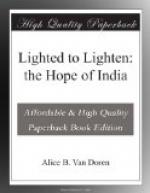Our visit happens to be on a Thursday afternoon, which is Mothers’ Day. Thirty or more have gathered for an hour of sewing. It is interesting to see mothers of families taking their first lessons in hemming and overcasting, and creating for the first time with their own hands the garments for which they have always been dependent on the bazaar tailor. For these women have never been to school—their faces bear that shut-in look of the illiterate, a look impossible to define, but just as impossible to mistake when once it has been recognized. With the mothers are a group of girls of ten or twelve, who are learning sewing at an earlier age, when fingers are more pliant and less like to thumbs. Then there are the babies, too—most of them health-centre babies, who come for milk, for medicine, for weighing, over a familiar and oft-traveled road. Fond mothers exhibit them with pride to the doctor, and there is much comparison of offspring, much chatter, and much general sociability.
Back of the dispensary is the milk room, where in an adapted and Indianized apparatus, due to the doctor’s ingenuity, the milk supply is pasteurized each day, and given out only to babies whose mothers are positively unable to nurse them, and are too poor to buy.
Of some of the difficulties encountered Dr. Vera Singhe will tell in her own words:
“The work of the midwife is carried out in the filthiest parts of the city among the lowest of the city’s population, both day and night, in sun and rain ... A patient whose ‘address’ was registered at the Triplicane Centre was searched for by a nurse on duty in the locality of the ‘address’ given, and could not be found. Much disappointed, the nurse was returning to the centre, when to her bewilderment she found that her patient had been delivered in a broken cart.”
Of some of the actual cases where mothers have been attended by untrained barber women, the details are too revolting to publish. Imagine the worst you can, and then be sure that your imagination has altogether missed the mark.
Of the reaction upon ignorance and superstition Dr. Vera Singhe says, “In Triplicane dispensary as many as sixty cords around waists and arms and variously shaped and sized pieces of leather which had been tied in much trust and confidence to an innocent sufferer with the hope of obtaining recovery have been in a single day removed by the mothers themselves on seeing that our treatment was more effective than the talisman.”
Weighing, feeding, bathing, prevention of disease, simple remedies—knowledge of all these goes out from the health centres to the unsanitary homes of crowded city streets. So far one woman’s influence penetrates.
In a Hospital.
It was on a train journey up-country from Madras, some twelve years ago, that I first met Dr. Paru. She and I shared the long seat of the small second-class compartment, and in that close neighborliness I soon fell to wondering. From her dress I knew her to be a Hindu, yet her jewels were few and inconspicuous. She was most evidently of good family, yet she was traveling unattended.




